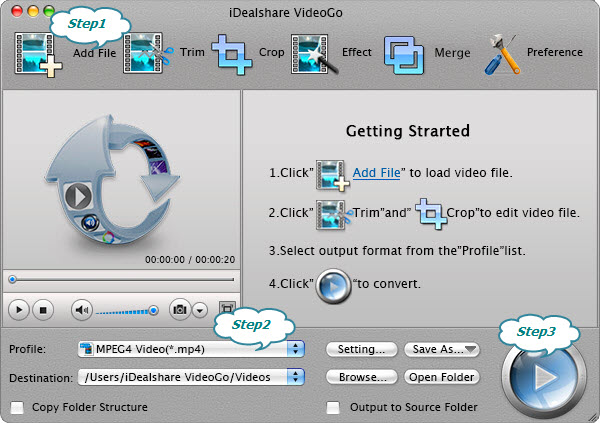March 18th 2015 by Harvey Taylor
Tags: AVI to MJPEG
Overview
MacVCD Player for Mac. MacVCD Player for Mac OS is the easy way to play VCD, and almost everything else with this easy to use media player for Mac OS 8/9. MacVCD Player for Mac OS 8/9 can play VCD, AVI, DivX, MPEG, video, Quicktime movies and more.It offers all the playback features you need and the ease of use you really want from a video player. Mac MKV Converter is the best MKV converter for Mac software. It is the real all-in-one solution for Mac users who want to convert DVD to MKV or convert all popular video file like WMV, MP4, MOV, FLV, AVI to MKV for put on their mobile players. Macgo Mac Media Player Macgo Mac Media Player is a totally free media player for macOS which is capable of replaying DVD, VideoCD, AVI, MKV, MOV, FLV, WMV, MP4, MP3, WMA and other formats on Mac computer in high quality. And this free AVI video player for Mac fully supports to embed subtitles and allow users to search for the videos and play. System Requirements of Mac Blu-ray Player. Supported OS: Mac OS X 10.7 or above (including macOS Catalina and macOS Big Sur) Processor: 1GHz Intel CPU or above; RAM: 1G RAM or more; Optical Drive: Blu-ray drive.
If it happened that all your AVI files come across problems like they cannot be played by the digital player, or they can be played but you cannot adjust the playback progress, or you cannot seethe pictures but only hear the sound and etc. Then, may be you have to set the files AVI to MJPEG codec or other specific codec, such as MPEG-1, MPEG-2, WMV1, WMV2, H.263, H.263p, orH.264/MPEG-4 AC.
This article will not only take MJPEG for example and show you how to set AVI to MJPEG codec (the way you learned can also be applied to AVI to any codes that AVI adopted) but will also explainwhy digital players that promised to support AVI files actually do not.
I think it would be necessary to know what AVI and MJPEG are, what characters they have and then you might be able to figure out why by yourself.
What is AVI?
AVI is a popular video format which can be seen in games or educational software lead-ins and of course a lot of videos from social networks like YouTube and films.
According to Wikipedia, AVI, Audio Video Interleaved (also Audio Video Interleave), is a multimedia container format introduced by Microsoft in November 1992 as part of its Video for Windowssoftware. AVI files can contain both audio and video data in a file container that allows synchronous audio-with-video playback.
AVI is kind like a box and in this box , audio/visual data would be stored in virtually any compression schemes (video codec), including Full Frame (Uncompressed), Intel Real Time (Indeo),Cinepak, , Editable MPEG, VDOWave, ClearVideo/RealVideo, QPEG, and MPEG-4 Video MPEG-1, MPEG-2, WMV1, WMV2, H.263, H.263p, H.264/MPEG-4 AC, or as DiveX and Xvid.
Well, this cause a problem: there is no standard codec for it, thus some digital player claim to support AVI files fail to play it fluently, because the fact is that what they really mean is itcan support AVI files of certain video codec.
What is MJPEG?
Again, let see how Wikipedia defines it: MJPEG, or Motion JPEG or M-JPEG, full name Motion Joint Photographic Experts Group, is a video compression format originally developed for multimedia PCapplications.
MJPEG is simple to implement because it uses a mature compression standard (JPG) with well-developed libraries, and it's an intraframe method of compression.

M-JPEG standard emerged from a market-adoption process rather than a standards body, so it enjoys broad client support - most major web browsers and players provide native support and plug-ins areavailable for the rest.
Now, let's take Bigasoft Total Video Converter Mac version for example to learn how to set AVI to MJPEG standard, also this may be applied to AVI to Intel Real Time (Indeo), Cinepak, ,EditableMPEG, VDOWave, ClearVideo / RealVideo, QPEG, and MPEG-4 Video MPEG-1, MPEG-2, WMV1, WMV2, H.263, H.263p, H.264/MPEG-4 AC, or as DiveX and Xvid.
First, make preparations by downloading and launching Bigasoft Total Video Converter.
Second , Four steps to set AVI to MJPEG codec.
Step 1 Put in the AVI file that you want to set into MJPEG codec.
Method 1: Drag the file and drop it into the right field of the software
Method 2: Click Add File and choose the file that you want to convert.
Tip: To do batch setting, you can add several files at the same time.
Mjpeg Viewer Mac
Step 2 Choose the format from the right side of Profile, in this case, choose AVI, yes, the same as the source file.
Step 3 Click Setting and choose Advanced Settiing, choose Motion JPEG under Video Codec
Tip: you can choose any video codec that is supported by the player.
Step 4 Convert.
Tip: If you do not set the destination, the converted file will be automatically stored in the folder named Bigasoft Total Video Converter. If you want to put it somewhere else, you can clickBrowse button and set the access manually.

You can enjoy your video now.
Conclusion:
Bigasoft Total Video Converter is the most easy way to set AVI to MJPEG codec, it is easy to use, it can do batch setting by just one click, it canoffer high-quality output MP4, , It works the same way when it is applied to Intel Real Time (Indeo), Cinepak, Editable MPEG, VDOWave, ClearVideo / RealVideo, QPEG, and MPEG-4 Video MPEG-1, MPEG-2,WMV1, WMV2, H.263, H.263p, H.264/MPEG-4 AC, or as DiveX and Xvid. If you want set the video code for other formats like, M4A, 3GP, MKV, WMV, RM, MOV, FLV,WTV, MXF, MVI, F4V, Apple ProRes MOV, WebM,VP8, 720p, 1080p, 1080i HD, AVCHD videos this will also work.
To find out more Bigasoft Solutions to enjoy your new digital life, you can go here.
Posted by Harvey Taylor. By the way, you may join me on Google+.
Motion JPEG, abbreviated as M-JPEG or MJPEG, was originally developed for multimedia PC applications. Each video frame or interlaced field of a digital video sequence in M-JPEG is separately compressed as a JPEG image. And now it is used by video-capture devices such as digital cameras, IP cameras, and webcams; and by non-linear video editing systems. M-JPEG enjoys native support by the QuickTime Player, the PlayStation console, and browsers such as Safari, Google Chrome, and Mozilla Firefox.
Encoding
Motion JPEG uses a lossy form of intraframe compression based on the discrete cosine transform (DCT). This mathematical operation converts each frame/field of the video source from the spatial (2D) domain into the frequency domain (aka transform domain.) A perceptual model based loosely on the human psychovisual system discards high-frequency information, i.e. sharp transitions in intensity, and color hue. In the transform domain, the process of reducing information is called quantization. In laymen's terms, quantization is a method for optimally reducing a large number scale (with different occurrences of each number) into a smaller one, and the transform-domain is a convenient representation of the image because the high-frequency coefficients, which contribute less to the over picture than other coefficients, are characteristically small-values with high compressibility. The quantized coefficients are then sequenced and losslessly packed into the output bitstream. Nearly all software implementations of M-JPEG permit user control over the compression-ratio (as well as other optional parameters), allowing the user to trade off picture-quality for smaller file size. In embedded applications (such as miniDV, which uses a similar DCT-compression scheme), the parameters are pre-selected and fixed for the application.
M-JPEG is an intraframe-only compression scheme (compared with the more computationally intensive technique of interframe prediction). Whereas modern interframe video formats, such as MPEG1, MPEG2 and H.264/MPEG-4 AVC, achieve real-world compression-ratios of 1:50 or better, M-JPEG's lack of interframe prediction limits its efficiency to 1:20 or lower, depending on the tolerance to spatial artifacting in the compressed output. Because frames are compressed independently of one another, M-JPEG imposes lower processing and memory requirements on hardware devices.
As a purely intraframe compression scheme, the image-quality of M-JPEG is directly a function of each video frame's static (spatial) complexity. Frames with large smooth-transitions or monotone surfaces compress well, and are more likely to hold their original detail with few visible compression artifacts. Frames exhibiting complex textures, fine curves and lines (such as writing on a newspaper) are prone to exhibit DCT-artifacts such as ringing, smudging, and macroblocking. M-JPEG compressed-video is also insensitive to motion-complexity, i.e. variation over time. It is neither hindered by highly random motion (such as the surface-water turbulence in a large waterfall), nor helped by the absence of motion (such as static landscape shot by tripod), which are two opposite extremes commonly used to test interframe video-formats.
For QuickTime formats, Apple has defined two types of coding: MJPEG-A and MJPEG-B. MJPEG-B no longer retains valid JPEG Interchange Files within it, hence it is not possible to take a frame into a JPEG file without slightly modifying the headers.
Advantages & Disadvantages
Advantages
It is simple to implement because it uses a mature compression standard (JPG) with well-developed libraries, and it's an intraframe method of compression.
It tolerates rapidly changing motion in the video stream, whereas compression schemes using interframe compression can often experience unacceptable quality loss when the video content changes significantly between each frame.
Because the M-JPEG standard emerged from a market-adoption process rather than a standards body, it enjoys broad client support — most major web browsers and players provide native support and plug-ins are available for the rest.
Minimal hardware is required because it is not computationally intensive.
Mjpeg Viewer
Disadvantages
Mpeg Player For Mac
Unlike the video formats specified in international standards such as MPEG-2 and the format specified in the JPEG still-picture coding standard, there is no document that defines a single exact format that is universally recognized as a complete specification of “Motion JPEG” for use in all contexts. This raises compatibility concerns about file outputs from different manufacturers. However, each particular file format usually has some standard how M-JPEG is encoded. For example, Microsoft documents their standard format to store M-JPEG in AVI files, Apple documents how M-JPEG is stored in QuickTime files, RFC 2435 describes how M-JPEG is implemented in an RTP stream, and an M-JPEG CodecID is planned for the Matroska file format.
JPEG is inefficient, using more bits to deliver equal quality, compared to more modern formats (such as JPEG 2000 and H.264/MPEG-4 AVC). Since the development of the original JPEG standard in the early 1990s, technology improvements have made interframe compression possible. Technology improvements can be found in the designs of H.263v2 Annex I and MPEG-4 Part 2, which use frequency-domain prediction of transform coefficient values, and in H.264/MPEG-4 AVC, which uses spatial prediction and adaptive transform block size techniques and more sophisticated entropy coding than what was practical when the first JPEG design was developed. These new developments make M-JPEG appear outdated and inefficient.